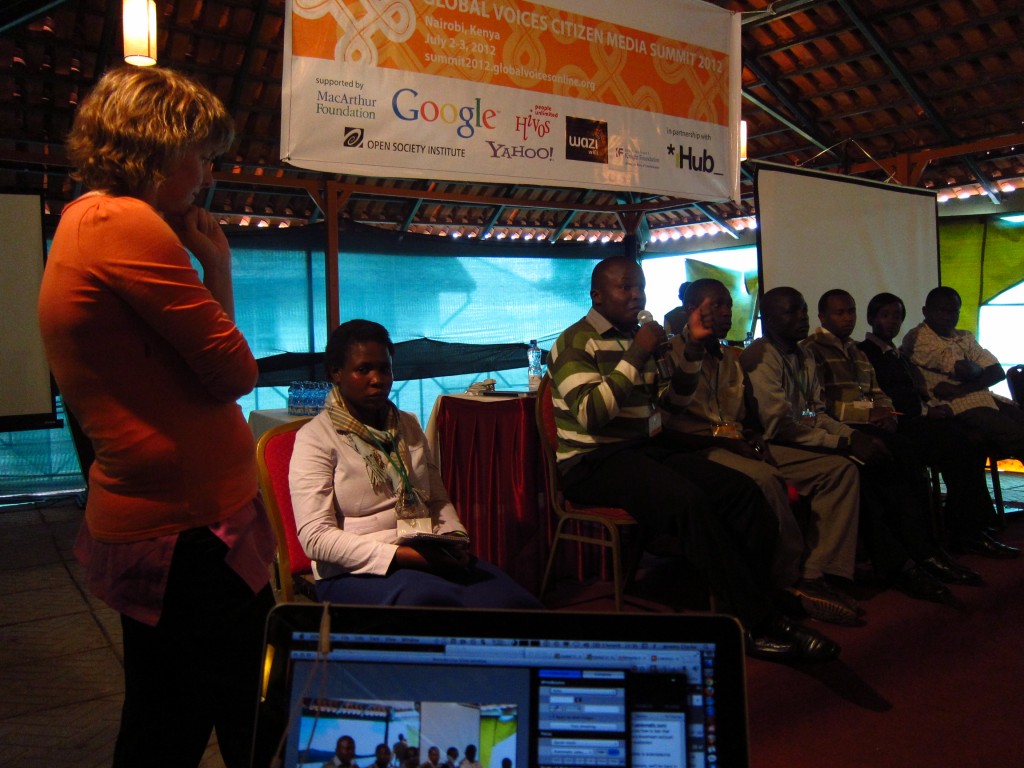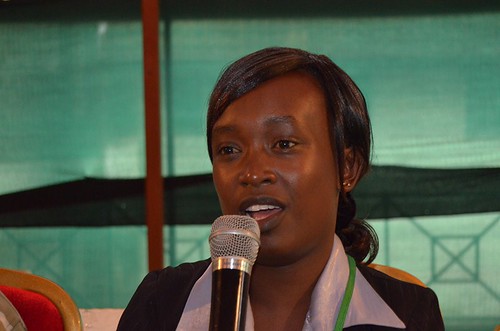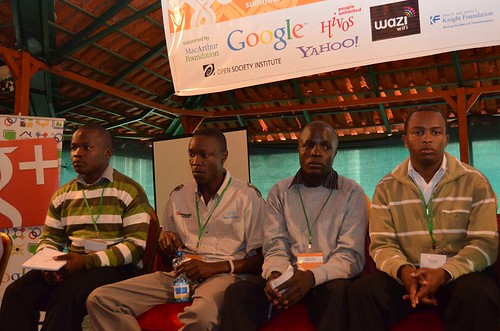by: Kibera News Network February 8th, 2013 comments:
This post by our member Steve Banner, of Kibera News Network (originally posted on the Voice of Kibera) explains how rumours resulted in violence during the recent party candidate nominations in January. A distinct mistrust of official channels of information is evident: if no one knows what to believe, suspicion and anger are quick to arise. This is one reason that Map Kibera is working to build accurate and trusted local networks of information in Nairobi slums during the upcoming elections.
—-

Destruction of Red Rose School, Kibera. Photo by Lee Ibrahim.
Kibera street political analysts, as I may call them, and rumour mongers, have a very thin line separating them if the happenings of the past few days is anything to go by.
After fierce campaigns on 6th and 7th January, the ODM nominations were to take place on 18th. The 18th came and people went to vote in one peace each confident that his or her candidate will clinch the party ticket.
After a full day of voting, rumours took over and went round on Friday 19th that the ODM Sarangombe county representative ticket had gone to Mr. Owino Ko’tieno, this was later to be confirmed by the returning officer at olympic primary school polling station.
The same rumours claimed that Mr. Amayo, a Kibra MP contestant had clinched the ODM ticket, hours later the same rumours reversed their claim that the confirmed winner was Mr. Ken Okoth. I never got to know how the confirmation came about and never bothered to ask since one didn’t actually need to ask, they would tell it to you anyway.
So I came to believe it when a friend told me that Mr. Ken Okoth had actually updated on social media that he had clinched the ODM ticket to run for Kibra MP.
It was at this point that the street political analysts of Kibera picked the story, and by saying street political analysts, I mean those individuals who stand by the roadside especially at newspapers vending points with a handful crowd around them, as they analyze the political situation of the moment. Try walking at olympic or kamkunji grounds, Kibera on a Sunday and you can’t miss them.
On this day, they took to analyze the possibility of Mr. Ken Okoth winning and how he had done it. According to one such analyst, Mr. Ken Okoth had only won in 2 polling stations and therefore could not be declared the winner. He argued that laini saba area residents had not been allowed to vote, and the area, according to him, was an Amayo stronghold.
As the rumour picked the story and went round with it, breaking it down in different versions, it seemed a group of youths decided to react to the rumour and marched to orange house in kilimani area, which houses ODM headquaters, to allegedly protest over why laini saba residents were denied a chance to participate in the nominations, where they were reported to have engaged in property destruction.
And despite the ODM electoral board announcing on a press conference that no certificate had been issued to any candidate yet, a rumour still went round that Mr. Owino Ko’tieno, who had been announced the winner of county rep. ODM ticket, had been denied the certificate, and, according to the rumour, given to Mr. Kajwang, who was also contesting for county representative ODM ticket in sarangombe. It’s believed that this could have been the reason for the rowdiness that followed thereafter that led to youths engaging in property destruction at Redrose school in olympic, a school that is believed to be owned by Mr. Ken Okoth, who, according to random sources in Kibera, was being accused of working to make sure Mr. Owino Kotieno did not have the certificate. There were several versions of this story depending on who you ask, and which side he/she supported and the mood on the ground. In one particular version, Mr. Ken Okoth is alleged to have been asked who he wanted to work with and mentioned Kajwang instead of Kotieno, but I could never tell who to believe among the several story tellers I listened to.
And even after ODM board made it clear that no certificate had been issued, the youths went ahead to lay barricades along Kibera drive near olympic stage.
Moments later, police from the general service unit were deployed to quell the lawlessness and violence. Running battles ensued, leaving scores of people injured among them 2 journalists from the mainstream media.
by: Kibera News Network July 13th, 2012 comments:

The Global Voices Summit, was a good opportunity for Map Kibera to get exposure, share and interact with different bloggers from all over the world.
On 2nd July, which was the first day of the summit, at 2pm when the Map Kibera team of Joshua Owino [KNN], Steve Oduor [KNN], Lucy Fondo [Mapper], Cosmas [map Mathare], Javin Ochieng [Map Mathare], Sande Wycliff [V.O.K], Yvonne Tiany [ Map Mathare], Vincent [Mukuru] and Kepha Ngito [Map Kibera Trust Director] took to the panel to present about map kibera trust.
Joshua and I shared how KNN, started, what we do with the limited resources we have to bring about change in our community.
Members of these different programs under map kibera trust shared in detail what they have been able to achieve in the 2- year approximate time that map kibera has existed.

Lucy Fondo speaking. Photo by @rezwan
For instance, Lucy Fondo , one of the mappers present at the summit, explained how, by the use of GPS gadgets, they have been able to map different facilities within Kibera and later been able to revise the maps in different topics that affect the community directly such as health, education, security and Water & Sanitation.
These maps have played a great role in improving the services offered by the government in these respective topics, for example, the local governing authorities have used the security map to help improve security especially around the black spots identified in the map. the map on water and sanitation has also been of great importance to the government-owned Nairobi Water Company which has relied on the map, to identify areas in Kibera hit by water shortage.
KNN on the other hand, use flip camera to make video on issues and happenings in different areas within Kibera, through the Youtube channel, www.youtube.com/kiberanewsnetwork which are linked to the map created by the mappers thus helping to identify on the map what happens at a particular place.
Sande Wycliff of Voice of Kibera explained how through ushahidi platform, they have been able to get the community members to send reports that come as text messages on the site, www.voiceofkibera.org , on events and things that take place within Kibera, the report is later verified by a team of editors and then appears on the site. which uses the map to show where a certain report was sent from.

Sande, Joshua, Steve, and Vincent on panel. Photo by @rezwan
Map Kibera also shared how the information sharing has helped improve the community and how it has been extended to slums of Mathare and Mukuru, where other young people like Cosmas, Yvonne, Javin and Vincent, who were also present at the summit, shared their experiences in these respective regions.
On 3rd of July which was the second day of the summit, Map Kibera director Kepha Ngito gave a presentation with an overview of the whole trust and it’s relation to the community where he later answered questions from participants.
Steve, KNN
by: Kibera News Network July 4th, 2012 comments:
Winning post by Steve Banner, of Kibera News Network, for the Global Voices Summit 2012 blogging scholarship competition:
After so much bloodshed in last general elections, The government of Kenya is doing everything to avoid the repeat of what happened in 2007.
In informal settlements and slums such as Kibera, where the post Election Violence was at its peak, the rise of Citizen journalism has helped in information gathering and sharing. hence becoming a vital tool to spread the message of peace among the youths, who are mostly the target by politicians in carrying out negative vices and violence in the community.
In Kibera, we have seen the rise of citizen journalism, who collect information in their communities in form of reports, news and also documentaries. one such group is the Kibera News Network, which comprises of youths born and brought up in Kibera slums hence they understand the community well, better than the mainstream media who just focus on the negative side of the community.
KNN collect stories in Kibera then organise for community screenings within Kibera where members of the community get information on what take place in different villages, through this screenings come forums where community members share opinions on how to create a peaceful society and discuss different projects going on within Kibera and how they can get to benefit from this projects. this help bring about togetherness hence creating harmony within the community.
Citizen media can also get to monitor elections from the grassroots since they are community based, hence helping to bridge the gap of misinformation which may have contributed to last post election violence.
They also organise Peace walks within Kibera which help bring together the community and the aspiring political candidates who give speeches preaching peace and togetherness among the community members.
However, there is still a lot to be learnt by citizen journalists, given that most of them may be green in journalism field and may need a lot of training in handling the heat that comes with election monitoring and also getting the necessary support in organising peace forums within the community and engaging them in civic education.
Citizen media has overcome many obstacles and achieved a lot. especially in educating the community and organising successful Peace forums.
Originally posted by Steve on his blog, stevebanner32.



